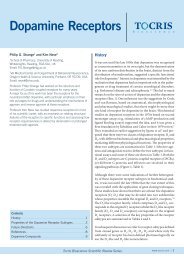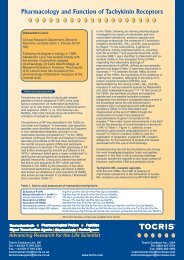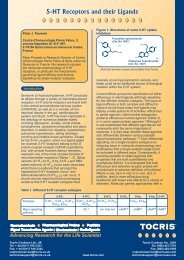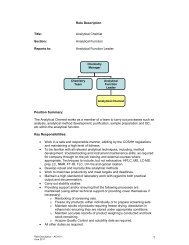Molecular Biology of Histamine ReceptorsBoth the histamine H1 and H2receptor belong tothe large family of G-protein coupled receptors(GPCRs). The cDNA encoding a bovine H1receptor protein was cloned in 1991 after anexpression cloning strategy in Xenopusoocytes. 32 The deduced amino acid sequencerevealed a 491 amino acid protein of 56 kDa.Using the cDNA sequence encoding the bovineH1receptor, the cDNA sequences and intronlessgenes encoding the rat, 33 guinea-pig, 34, 35human36-39 and mouse40H1receptor proteinswere cloned soon thereafter. The proteins areslightly different in length, highly homologous anddo not show major differences in pharmacology.Analysis of the 5-flanking region of the human, ratand guinea-pig gene33, 34, 36 resulted in theidentification of several DNA-binding motifs,including potential glucocorticoid responsiveelements. The human H1receptor gene resideson chromosome 3. 41Gantz et al 42 were the first to clone a cDNAencoding a 359 amino acid H2receptor. Usingdegenerate primers based on the knownsequence similarity of various GPCRs, the H2receptor sequence was obtained from caninegastric parietal cDNA by PCR. Soon thereafter,the intronless genes encoding the rat, 43 human, 44guinea-pig45 and mouse46H2receptor werecloned by means of homology screening. As forthe H1receptor, the receptor proteins are slightlydifferent in length, but do not show majorpharmacological differences. Identification of thepromotor region of the human H2receptor generevealed the existence of regulatory transcriptionsites and regions displaying stimulatory andinhibitory effects on gene expression monitored ina luciferase assay. 47 Recent studies haveindicated that the human H2receptor gene resideson chromosome 5. 45 Interestingly, severalpolymorphisms have been found in the human H2receptor gene48and one of the mutations hasbeen linked to schizophrenia. 49Although the genetic information for the H1and H2receptor has been available for some years now,as yet no information on the primary structure ofthe H receptor is known.3Signal Transduction of the HistamineReceptorsThe histamine H1receptor is associated with thephospholipase C-catalyzed formation of inositol1,4,5-triphosphate (IP 3) and 1,2-diacylglycerol(DAG). Histamine induces production of inositolphosphates in several tissues (including brain,airway, intestinal and vascular smooth muscle 10)via a pertussis toxin-insensitive G-protein.Although the G-protein probably belongs to theG q/G11family, the actual nature of the pertussintoxin-insensitive G-protein remains unclear. SinceCa2+is involved in the regulation of many cellularfunctions, the increase of the intracellular Ca2+concentration following H1receptor stimulationcan explain a variety of cellular responses, suchas nitric oxide production, cAMP and cGMPaccumulation and phospholipase A2andphospholipase D activation. 10 Yet, studies with G-protein toxins and in calcium-free mediumindicate that both the H1receptor-mediatedactivation of phospholipase A2and cAMPelevation are also mediated by an unknown,secondary mechanism (G-protein mediated?).The histamine H2receptor is coupled to theadenylate cyclase system in a variety of tissues(e.g. brain, stomach, heart, gastric mucosa,lung). 10 Moreover, cell lines transfected with thecloned H2receptor genes showed an H2receptor-mediated increase of cAMP. 50-52 Althoughcoupling of the H2receptor to adenylate cyclase iswell accepted, some findings argue against auniversal role of cAMP. New signalling pathwayshave recently been described for the H2receptor.In differentiated HL-60 cells and CHO or HEPAcells transfected with the H2receptor cDNA, an H2receptor-mediated increase of the intracellularCa2+concentration and/or IP3levels wasobserved. 52-56 Moreover, in CHO cells expressingthe rat H2 receptor, activation of the H2receptorresulted in an inhibition of the release ofarachidonic acid induced by either constitutivepurinergic receptors or a Ca2+ -ionophore, 51 aswell as an increase in cAMP. These new signaltransduction pathways are both regulated viaunknown, cAMP-independent pathways.The H3receptor is also thought to belong to thesuperfamily of G-protein coupled receptors. Fromboth functional and binding studies an interactionwith a G-protein is suggested. 10 The concept of G-protein involvement is further strengthened by arecent study57showing a pertussis toxin sensitivestimulation of [ 35S]-GTPS binding in rat corticalmembranes. At present, almost nothing is knownabout the intracellular biochemical pathways thatare stimulated via the H3-receptor. Severalstudies failed to show a coupling of H3receptors tointracellular cAMP levels; 10 a not completelyunderstood, negative coupling to phospholipaseC was shown in HGT-1 gastric tumor cells. 58 Acoupling to N-type Ca2+-channels, as shown forother presynaptic receptors, has been reported infunctional studies with heart and duodenalpreparations. 59, 60 The biochemical basis for thiscoupling is also, as yet, unknown.Further DirectionsMany new developments are awaited, particularlyin the field of the H3receptor where both theprimary receptor structure and the signaltransduction pathway(s) are, as yet, unknown.However, new developments are expected in thenext five years. For the H1 and H2receptors,availability of the cDNAs will provide new insightson structure-function relationships of the receptorprotein, receptor regulation, and gene expression,in the years to come.4
References 31. Jansen et al (1994) Characterization of the binding of thefirst selective radiolabelled histamine H3receptor antagonist,1. Schwartz et al (1991) Histaminergic transmission in[ 125I]-iodophenpropit, to rat brain. Br.J.Pharmacol. 113 355.mammalian brain. Physiol.Rev. 71 1.32. Yamashita et al (1991) Expression cloning of a cDNA2. Ring et al (1985) Histamine and allergic deseases. In Newencoding the bovine histamine H1receptor.Trends in Allergy. Ed. J. Ring, pp 44, Springer-Verlag, Berlin.Proc.Natl.Acad.Sci.USA. 88 11515.3. Ash and Schild (1966) Receptors mediating some actions of 33. Fujimoto et al (1993) Genomic cloning of the rat histaminehistamine. Br.J.Pharmacol. 27 427.H1receptor. Biochem.Biophys.Res.Comm. 190 294.4. Black et al (1972) Definition and antagonism of histamine H234. Horio et al (1993) Molecular cloning of the guinea-pigreceptors. Nature 236 385.histamine H1receptor gene. J.Biochem. 114 408.5. Arrang et al (1983) Auto-inhibition of brain histamine release 35. Traiffort et al (1994) Guinea-pig histamine H1receptor. I.mediated by a novel class (H 3) of histamine receptors.Gene cloning, characterization, and tissue expressionNature 302 832.revealed by in situ hybridization. J.Neurochem. 62 507.6. Zhang et al (1997) Histamine H1-receptor antagonists. In36. Fukui et al (1994) Molecular cloning of the human histamineBurger’s Medicinal Chemistry and Drug Discovery, FifthH1receptor gene. Biochem.Biophys.Res.Comm. 201 894.Edition. Ed. M. E. Wolff, pp 495. John Wiley & Sons, Inc.37. De Backer et al (1993) Genomic cloning, heterologous7. Schlicker et al (1994) Modulation of neurotransmitter releaseexpression and pharmacological characterization of a humanvia histamine H3heteroreceptors. Fundam.Clin.Pharmacol. 8histamine H1receptor. Biochem.Biophys.Res.Comm. 197128.1601.8. Zingel et al (1995) Developments in histamine H1-receptor38. Moguilevsky et al (1994) Stable expression of human H1-agonists. In Progress in Drug Research, Ed. E. Jucker, pphistamine-receptor cDNA in Chinese hamster ovary cells -49. Birkhauser Verlag, Basel (Switzerland).Pharmacological characterisation of the protein, tissue9. Leurs et al (1994) Site-directed mutagenesis of thedistribution of messenger RNA and chromosomal localisationhistamine H1receptor reveals a selective interaction ofof the gene. Eur.J.Biochem. 224 489.asparagine207with subclasses of H1receptor agonists.39. Smit et al (1996) Regulation of the human histamine H1Biochem.Biophys.Res.Comm. 201 295.receptor stably expressed in Chinese hamster ovary cells.10. Leurs et al (1995) Molecular pharmacological aspects ofBr.J.Pharmacol. 117 1071.histamine receptors. Pharmacol.Ther. 66 413.40. Inoue et al (1996) Characteristics of the mouse genomic11. Parsons et al (1977) Dimaprit -[S-[3(N,Ndimethylamino)propyl]isothiourea]-A highly specific41. Leconiat et al (1994) Chromosomal localization of thehistamine H1receptor gene. Genomics 36 178.histamine H2receptor agonist. Agents Actions 7 31.human histamine H1-receptor gene. Hum.Genet. 94 186.12. Leurs et al (1995) The medicinal chemistry and therapeutic 42. Gantz et al (1991) Molecular cloning of a gene encoding thepotential of ligands for the histamine H3receptor. Inhistamine H2receptor. Proc.Natl.Acad.Sci.USA. 88 429.Prog.Drug Res. Ed. E. Jucker, pp 107. Birkhauser Verlag,43. Ruat et al (1991) Cloning and tissue expression of a ratBasel (Switzerland).histamine H2receptor gene. Biochem.Biophys.Res.Comm.13. Eriks et al (1992) Histamine H2-receptor agonists -179 1470.synthesis, in vitro pharmacology, and qualitative structureactivityrelationships of substituted 4-(2-Aminoethyl)thiazolesH2receptor. Biochem.Biophys.Res.Comm. 178 1386.44. Gantz et al (1991) Molecular cloning of the human histamineand 5-(2-Aminoethyl)thiazoles. J.Med.Chem. 35 3239.45. Traiffort et al (1995) The guinea-pig histamine H2receptor:14. Coruzzi et al (1996) Cardiovascular effects of the novelGene cloning, tissue expression and chromosomalhistamine H2receptor agonist amthamine: Interaction withlocalization of its human counterpart.the adrenergic system. Arch.Pharmacol. 353 417.Biochem.Biophys.Res.Comm. 211 570.15. Durant et al (1978) Impromidine (SK&F 92676) is a very46. Kobayashi et al (1996) Cloning, RNA expression andpotent and specific agonist for histamine H2receptors.chromosomal location of a mouse histamine H2receptorNature 276 403.gene. Genomics 37 390.16. Ganellin (1992) Pharmacochemistry of H1 and H2receptors. 47. Nishi et al (1995) Identification of the promoter region of theIn The Histamine Receptor. Ed. J. C. Schwartz and H. Haas,human histamine H2-receptor gene.pp 1. Wiley-Liss, New York.Biochem.Biophys.Res.Comm. 210 616.17. Van der Goot et al (1991) Structural requirements for48. Orange et al (1996) Allelic variations of the human histaminehistamine H2 agonists and H2antagonists. In Handbook ofH2receptor gene. Neuroreport 7 1293.Experimental Pharmacology. Ed. B. Uvnas, pp 573. Springer- 49. Orange et al (1996) Individuals with schizophrenia have anVerlag, Berlin.increased incidence of the H2R(649G) allele for the histamine18. Young et al (1988) Development of a new physiochemicalH2receptor gene. Mol.Psychiatr. 1 466.model for brain penetration and its application to the design 50. Leurs et al (1994) Pharmacological characterization of theof centrally acting H2receptor histamine antagonists.human histamine H2receptor stably expressed in ChineseJ.Med.Chem. 31 626.hamster ovary cells. Br.J.Pharmacol. 112 847.19. Smit et al (1996) Inverse agonism of histamine H251. Traiffort et al (1992) Expression of a cloned rat histamine H2antagonists accounts for upregulation of spontaneouslyreceptor mediating inhibition of arachidonate release andactive histamine H2receptors. Proc.Natl.Acad.Sci.USA. 93activation of cAMP accumulation. Proc.Natl.Acad.Sci.USA.6802.89 2649.20. Garbarg et al (1992) S-[2-(4-Imidazolyl)ethyl]isothiourea, a 52. Delvalle et al (1992) Characterization of H2receptor: linkagehighly specific and potent histamine H3receptor agonist.to both adenylyl cyclase and [Ca 2+ ] i signalling systems.J.Pharmacol.Exp.Ther. 263 304.Am.J.Physiol. 263 G967.21. Howson et al (1992) Two novel, potent and selective53. Gespach et al (1982) Identification and characterization ofhistamine H3receptor agonists. Bioorg.Med.Chem.Lett. 2 77.surface receptors for histamine in the human promyelocytic22. Van der Goot et al (1992) Isothiourea analogues ofleukemia cell line HL-60. Mol.Pharmacol. 22 547.histamine as potent agonists or antagonists of the histamine 54. Mitsuhashi et al (1989) Multiple signalling pathways ofH3-receptor. Eur.J.Med.Chem. 27 511.histamine H2receptors. J.Biol.Chem. 264 18356.23. Vollinga et al (1994) A new potent and selective histamine55. Burde and Seifert (1996) Stimulation of histamine H2-H3receptor agonist, 4-(1H-imidazol-4-ylmethyl)piperidine.receptors activates Ca2+influx in all-trans-retinoic aciddifferentiatedHL-60 cells independently of phospholipase CJ.Med.Chem. 37 332.24. Hey et al (1992) (R)--methylhistamine augments neural,or adenylyl cyclase. Arch.Pharmacol. 353 123.cholinergic bronchospasm in guinea-pig by histamine H156. Seifert et al (1992) Histamine increases cytosolic Ca2+inreceptor activation. Eur.J.Pharmacol. 211 421.dibutyryl-cAMP-differentiated HL-60 cells via H1receptors25. Coruzzi, G. et al (1995) Cardiovascular effects of selectiveand is an incomplete secretagogue. Mol.Pharmacol. 42 227.agonists and antagonists of histamine H3receptors in the57. Clark and Hill (1996) Sensitivity of histamine H3receptoranaesthetised rat. Arch.Pharmacol. 351 569.agonist-stimulated [ 35S]GTPS binding to pertussis toxin.26. Leurs et al (1995) Evaluation of the receptor selectivity of theEur.J.Pharmacol. 296 223.H3receptor antagonists, iodophenpropit and thioperamide:58. Cherifi et al (1992) Purification of a histamine H3receptoran interaction with the 5HT3receptor revealed.negatively coupled to phosphoinositide turnover in the humanBr.J.Pharmacol. 116 2315.gastric cell line HGT-1. J.Biol.Chem. 267 25315.27. Arrang et al (1987) Highly potent and selective ligands for59. Poli et al (1994) Signal transducing mechanisms coupled tohistamine H3receptors. Nature 327 117.histamine H3 receptors and 2adrenoceptors in the guineapigduodenum: Possible involvement of N-type Ca++receptor antagonists thioperamide and clobenpropit in rat28. Mochizuki et al (1996) Brain penetration of the histamine H3and mouse, determined with ex vivo [ 125channels. J.Pharmacol.Exp.Ther. 270 788.I]iodophenpropit60. Endou et al (1994) Histamine H3-receptor signalling in thebinding. Brain Res. 743 178.heart: Possible involvement of G i/Goproteins and N-type29. Stark et al (1996) Development of histamine H3-antagonists.Ca++channels. J.Pharmacol.Exp.Ther. 269 221.Drugs Future. 21 507.30. Ligneau et al (1994) [ 125I]Iodoproxyfan, a new antagonist tolabel and visualize cerebral histamine H3receptors.J.Pharmacol.Exp.Ther. 271 452.5







